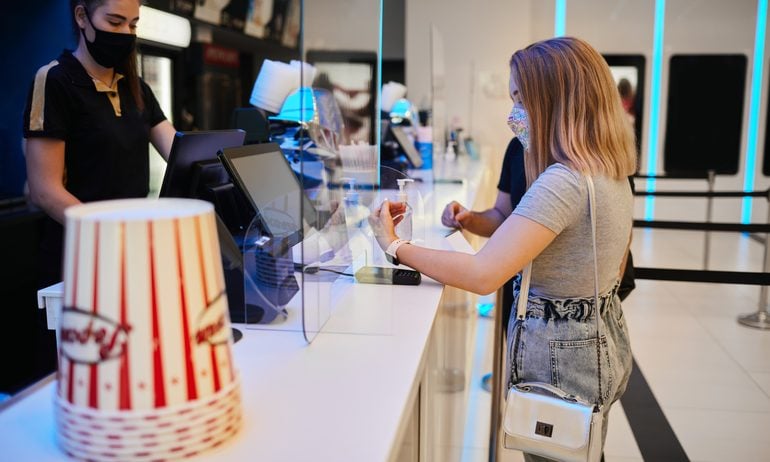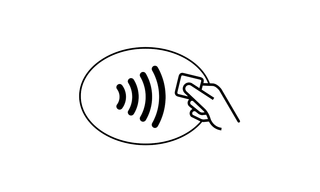Contactless Payments: How They Work and Why You Can Trust Them
Touchless methods like tap-to-pay and digital wallets are convenient and secure. Here’s what to know about them.

Many or all of the products on this page are from partners who compensate us when you click to or take an action on their website, but this does not influence our evaluations or ratings. Our opinions are our own.
Contactless payments can make transactions more convenient, secure and sanitary than inserting a card or paying with cash. And these days, more Americans are opting to wave or tap their devices to pay that way.
In a 2024 digital wallet satisfaction study conducted by J.D. Power, 48% of U.S. consumers said they had used a digital wallet within at least 90 days from when the survey was done — a 12 percentage point increase from the previous year.
Plus, more businesses are accepting contactless payments than ever before: According to 2024 data from the Visa payment network, 80% of all in-person purchases made with a Visa card happen at a contactless-enabled merchant.
Contactless payments, specifically in the form of digital wallets, were first broadly adopted over a decade ago with the launch of Google Wallet in 2011 and Apple Pay in 2014. But consumer interest in contactless payments spiked during the COVID-19 pandemic.
Since then, the payment method has grown in usage and is expected to continue. In fact, analysts predict that the value of digital wallet tap-to-pay transactions will grow by more than 150% by 2028.
Types of contactless payments and how they work
Contactless payment methods include cards with tap-to-pay functionality, mobile wallets that allow you to store a card and pay through your phone, and QR codes in some cases. Contactless payments use radio-frequency identification (RFID) or near-field communication (NFC) technology to allow customers to wave or tap their cards, phones or other devices near a point-of-sale system enabled with contactless payment technology.
Here’s how specific contactless payment methods work.

Contactless symbol.
Tap-to-pay cards
True, the word "tap" doesn’t exactly scream contactless. But "tap to pay" credit and debit cards really only need to be within a couple of inches of the payment terminal. That's because the contactless cards have little antennas inside that transmit customers' information to the card reader.
Payment cards with contactless capability have a logo that looks like a sideways Wi-Fi symbol of radiating waves. Retail payment terminals that accept contactless payments have the same symbol.
Contactless-enabled cards don’t require a smartphone to complete the payment, and you don’t have to use a PIN. Effectively every major credit card issuer offers tap-to-pay credit cards. For example, Visa says that over 300 million of the payment network’s cards are contactless-enabled.
Mobile payments
Unlike tap-to-pay cards, phone payments require a little prep work before you get to the checkout counter. First, you must enter your payment card information into your mobile wallet app. Then, the card is saved and available to use. The most popular digital wallet services are Apple Pay, Samsung Pay and PayPal.
To pay during checkout, hold your phone near a card reader and your phone will ask for authentication. That’s the normal unlocking procedure with your phone, whether you opt to tap in a numeric code, use face identification or double-click on the side of your phone. Many smartwatches work, too, as long as they have the required technology. When successful, the terminal will confirm your payment was received.
Some countries like Canada and the UK have contactless payment limits, but in the U.S. there are no limits on the number of contactless transactions you can make in a day or how much you can spend per transaction.
QR codes
QR codes — or “quick response” codes — can be scanned with your smartphone's camera to access a website. Some merchants allow you to pay for items this way: By scanning the QR code, you'll be taken to a payment page or a peer-to-peer payment app like PayPal or Venmo.
Note that QR codes can be less secure than NFC payments because they are more easily intercepted.
Are contactless payments secure?
Some consumers may be hesitant to opt for contactless payment methods due to fear of fraud and theft. However, contactless payment methods are safer than the old method of swiping your card.
That’s because the card or phone sends encrypted payment information to the terminal that’s unique to each payment, essentially masking your real credit card number. Even if the payment information was intercepted, it would be useless to a thief.
Contactless payments and credit card rewards
When you use a contactless method like a digital wallet or tap-to-pay to make a purchase, you’ll still earn your rewards like you would with a physical credit card.
Credit card issuers rely on merchant category codes (MCCs) to determine whether your purchase qualifies for certain rewards, and these codes remain the same, regardless of how you pay with your card.
In fact, some credit cards specifically reward you for using a digital wallet, while others come with perks that make doing so easier.
A version of this article was written by NerdWallet and was originally published by The Associated Press.
Find the right credit card for you.
Whether you want to pay less interest or earn more rewards, the right card's out there. Just answer a few questions and we'll narrow the search for you.


